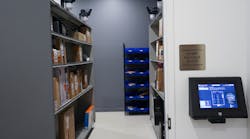Have mail deliveries become a logistical nightmare? Disorganized lobbies, unsecured packages, overwhelmed staff—parcels are a problem. What building managers need is a way to create a mini fulfillment center. Enter the smart mailroom, which automates postal delivery and pickup.
A smart mailroom is equipped with IoT technologies like self-service scanners, inventory logs and security cameras with analytics. The entire mail experience is simplified from the second a package arrives. It’s ideal for offices, government facilities, multifamily, mixed use and dormitories. Learn about five reasons building managers are embracing smart mailrooms: tenant experience, clutter reduction, labor skills, vendor relationships and security.
1. Improve the Tenant Experience
Mail is a crucial amenity, especially in residences. Anything can be shipped these days, from furniture and appliances to prescriptions and groceries. But mail pickup from only 9 to 5 during the business week creates delays. A smart mailroom eliminates that frustration. It matches the realities of occupant schedules without needing staff present, including early mornings, evenings and weekends.
“Self-service is the name of the game these days. Outsource mailroom labor to the customer rather than force an interaction between staff and tenants,” said Ned Hill, CEO of Position Imaging, which offers the Smart Package Room.
Another way to improve mail service is to add cold storage. No melting ice cream or deli products spoiling at room temperature. Refrigerators aren’t only for iced drink orders, though. Heat-sensitive medications are shipped in insulated coolers and can benefit from prolonged protection.
2. Reduce Clutter
Online shopping habits have shifted significantly in recent years. Friendlier shopping apps, new delivery services and COVID precautions have accelerated the rise in parcel shipments. While this is good news for e-commerce and carriers, it’s creating a major bottleneck for property owners.
The problem is that few facilities are built or staffed to handle a daily onslaught of packages. The lack of a dedicated mailroom leads to a cascading problem. Packages can pile up in hallways and lobbies, creating an unprofessional look as well as a tripping hazard. These stacks of mail are often unmonitored, which then creates a liability risk.
Properties are carving out mailrooms in underutilized areas. Options include repurposing basement storage, converting office space or erecting a small room in a lobby corner. But even a utility closet can be enough to hold deliveries. No matter the size, the location should be easily accessible to vendors and tenants.
3. Free Up Concierges
Concierges are experts at personalized service, but mail shouldn’t dominate their responsibilities. Their skills are best used for tailored assistance.
“Why would you have staff to serve residents but then have them only dole out packages? Mundane tasks are a poor use of personnel, especially in a labor shortage,” Hill argued.
“Front desk staff can be overwhelmed with manually logging deliveries and notifying every recipient. They also need accurate records, which can be challenging with package volume,” explained Rahul Ramakrishnan, lead product manager for Verkada and its Mailroom solution. “This is where automation can play a critical role in improving mailroom operations.”
With Mailroom by Verkada, a package label is scanned with a mobile app and text recognition matches the name to the recipient. Mailroom adds notes and a pickup location along with an automatic photo. Recipients are alerted via SMS, email or Slack, which they also use to confirm receipt. Verkada’s security cameras provide a live view of the mailroom as well as historical snapshots of scanned and retrieved items.
The Smart Package Room from Position Imaging works in a similar manner with a scanner that reads the label. Couriers place the package on a shelf—automation does the rest. Analytics on security cameras take a picture of the package, associating the image with the label record. Recipients receive a notification with a QR code and PIN. The same scanner reads their QR code, prompting audio instructions and laser guidance on where to retrieve a package.
As an operational benefit, smart mailrooms generate extensive logs that management can mine for trends. Not only is this helpful for tracking packages, but it can reveal details about usage. Do specific days have more deliveries? How often do packages sit for more than a day? What is the average size or weight of boxes? Use this data to finetune mail operations.
4. Strengthen Vendor Relationships
Consider how many mail carriers and delivery services enter your building in a given week. No matter the company, their workers are on a strict schedule. A smart mailroom makes their job easier and faster. They won’t need to:
- Find staff to receive or sign for packages
- Match box sizes to mail receptacles
- Leave parcels in an unsecured location
- Go to individual apartments or offices
A smart mailroom helps delivery personnel uphold courier compliance. It can drastically reduce failed deliveries, which is also a benefit for tenants. Be someone’s favorite delivery of the day.
5. Reduce Loss or Theft Risks
Every package has three custodians in its chain of custody: carrier, building destination and recipient. Automated mailrooms document every transfer step with photos and timestamps. Live video also deters theft.
“Smart mailroom software enables carriers to efficiently transfer ownership of a package to the building,” emphasized Ramakrishnan. “Because there is a record as soon as a delivery is scanned, carriers reduce liability while building managers are easily able to investigate lost or removed items.”
About the Author:
Jennie Morton has been covering the built environment since 2010.


